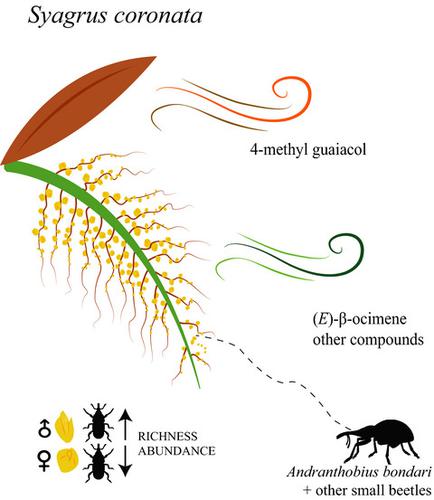当前位置:
X-MOL 学术
›
Plant Biol.
›
论文详情
Our official English website, www.x-mol.net, welcomes your feedback! (Note: you will need to create a separate account there.)
Reproductive biology of Syagrus coronata (Arecaceae): sex-biased insect visitation and the unusual case of scent emission by peduncular bracts.
Plant Biology ( IF 3.9 ) Pub Date : 2020-08-05 , DOI: 10.1111/plb.13162 C M Barbosa 1 , A C D Maia 2 , C Martel 3 , J C S Regueira 4 , D M do A F Navarro 5 , R A Raguso 6 , P Milet-Pinheiro 1 , I C Machado 1
中文翻译:

Syagrus coronata(Arecaceae)的生殖生物学:性偏向昆虫的拜访和带蒂小片散发气味的异常情况。
更新日期:2020-08-05
Plant Biology ( IF 3.9 ) Pub Date : 2020-08-05 , DOI: 10.1111/plb.13162 C M Barbosa 1 , A C D Maia 2 , C Martel 3 , J C S Regueira 4 , D M do A F Navarro 5 , R A Raguso 6 , P Milet-Pinheiro 1 , I C Machado 1
Affiliation

|
- Several monoecious species of palms have developed complex strategies to promote cross‐pollination, including the production of large quantities of floral resources and the emission of scents that are attractive to pollinators. Syagrus coronata constitutes an interesting model with which to understand the evolution of plant reproductive strategies in a monoecious species adapted to seasonally dry forests.
- We monitored blooming phenology over 1 year, during which we also collected and identified floral visitors and putative pollinators. We identified potential floral visitor attractants by characterizing the scent composition of inflorescences as well as of peduncular bracts, during both male and female phases, and the potential for floral thermogenesis.
- Syagrus coronata produces floral resources throughout the year. Its inflorescences are predominantly visited by a diverse assortment of small‐sized beetles, whose richness and abundance vary throughout the different phases of anthesis. We did not find evidence of floral thermogenesis. A total of 23 volatile compounds were identified in the scent emitted by the inflorescences, which did not differ between male and female phases; whereas the scent of the peduncular bracts was composed of only 4‐methyl guaiacol, which was absent in inflorescences.
- The composition of floral scent chemistry indicates that this palm has evolved strategies to be predominantly pollinated by small‐sized weevils. Our study provides rare evidence of a non‐floral scent emitting structure involved in pollinator attraction, only the second such case specifically in palms. The peculiarities of the reproductive strategy of S. coronata might play an important role in the maintenance of pollination services and pollen dispersion.
中文翻译:

Syagrus coronata(Arecaceae)的生殖生物学:性偏向昆虫的拜访和带蒂小片散发气味的异常情况。
- 几种雌雄同体的棕榈树已经制定了复杂的策略来促进异花授粉,包括生产大量花卉资源以及散发出授粉媒介吸引力的气味。Syagrus coronata构成了一个有趣的模型,通过该模型可以了解适应季节性干燥森林的一种雌性物种中植物繁殖策略的演变。
- 我们监控了超过1年的开花物候期,在此期间,我们还收集并确定了花朵访客和假定的传粉者。我们通过表征雄性和雌性阶段的花序以及小片的气味成分,确定了潜在的花卉访客引诱剂,以及花卉生热的潜力。
- Syagrus coronata全年生产花卉资源。它的花序主要由各种各样的小型甲虫造访,其丰富度和丰度在花期的不同阶段有所不同。我们没有发现花香生热的证据。从花序中散发出的气味中总共鉴定出23种挥发性化合物,这在雄性和雌性相之间没有区别。而带蒂cular片的气味仅由4-甲基愈创木酚组成,在花序中不存在。
- 花香化学成分表明,这种棕榈树已进化出策略,主要被小象鼻虫授粉。我们的研究提供了极少的证据表明传粉媒介吸引作用涉及非植物散发气味的结构,只有第二种情况专门针对棕榈。冠状链球菌繁殖策略的特殊性可能在维持授粉服务和花粉分散中起重要作用。



























 京公网安备 11010802027423号
京公网安备 11010802027423号